ESP SKODA FABIA 2008 2.G / 5J Owner's Guide
[x] Cancel search | Manufacturer: SKODA, Model Year: 2008, Model line: FABIA, Model: SKODA FABIA 2008 2.G / 5JPages: 252, PDF Size: 40.88 MB
Page 110 of 252
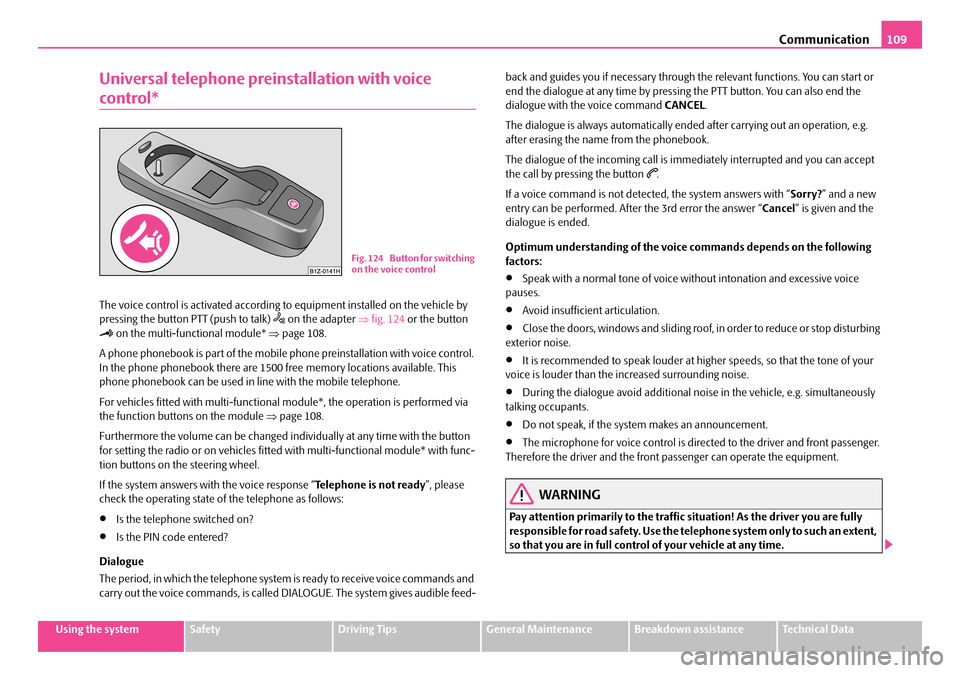
Communication109
Using the systemSafetyDriving TipsGeneral MaintenanceBreakdown assistanceTechnical Data
Universal telephone preinstallation with voice
control*
The voice control is activated according to equipment installed on the vehicle by pressing the button PTT (push to talk) on the adapter ⇒fig. 124 or the button on the multi-functional module* ⇒page 108.
A phone phonebook is part of the mobile phone preinstallation with voice control. In the phone phonebook there are 1500 free memory locations available. This phone phonebook can be used in line with the mobile telephone.
For vehicles fitted with multi-functional module*, the operation is performed via the function buttons on the module ⇒page 108.
Furthermore the volume can be changed individually at any time with the button for setting the radio or on vehicles fitted with multi-functional module* with func-tion buttons on the steering wheel.
If the system answers with the voice response “Telephone is not ready”, please check the operating state of the telephone as follows:
•Is the telephone switched on?
•Is the PIN code entered?
Dialogue
The period, in which the telephone system is ready to receive voice commands and carry out the voice commands, is called DIALOGUE. The system gives audible feed-
back and guides you if necessary through the relevant functions. You can start or end the dialogue at any time by pressing the PTT button. You can also end the dialogue with the voice command CANCEL.
The dialogue is always automatically ended after carrying out an operation, e.g. after erasing the name from the phonebook.
The dialogue of the incoming call is immediately interrupted and you can accept the call by pressing the button .
If a voice command is not detected, the system answers with “Sorry?” and a new entry can be performed. After the 3rd error the answer “Cancel” is given and the dialogue is ended.
Optimum understanding of the voice commands depends on the following factors:
•Speak with a normal tone of voice without intonation and excessive voice pauses.
•Avoid insufficient articulation.
•Close the doors, windows and sliding roof, in order to reduce or stop disturbing exterior noise.
•It is recommended to speak louder at higher speeds, so that the tone of your voice is louder than the increased surrounding noise.
•During the dialogue avoid additional noise in the vehicle, e.g. simultaneously talking occupants.
•Do not speak, if the system makes an announcement.
•The microphone for voice control is directed to the driver and front passenger. Therefore the driver and the front passenger can operate the equipment.
WARNING
Pay attention primarily to the traffic situation! As the driver you are fully responsible for road safety. Use the telephone system only to such an extent, so that you are in full control of your vehicle at any time.
Fig. 124 Button for switching on the voice control
NKO A05F 20.book Page 109 Wednesday, April 2, 2008 1:02 PM
Page 113 of 252

Communication112
Voice commands for operating the phone phone book
Other possible commands
Enter PIN code
A PIN code must be entered before operating the system.
– Press the PTT button.
– Give the command ENTER PIN/PIN CODE after the signal tone.
After this command the PIN code can be entered.
The entry of the PIN code is only possible if:
•The ignition and
•the mobile phone are switched on.
The digits zero to nine are permitted. The system detects no continuous digit c o m b i n a t i o n s s uc h a s t w e n t y - t h re e , b u t o n l y i n d i v i d u a l l y s po ke n d i g i ts ( t w o , t h re e ) . After each order of digits (separation through brief voice pause) the detected digits are repeated.
Notes for entering the PIN code
•When entering a PIN code with more than 8 digits, the system indicates “The PIN is too long”.
Voice commandActivity
SAVE/STORE NAMES/NAME/NUMBER
After this command a name with its telephone number can be stored in the phone phone book ⇒page 114.
SELECT NAMES/NAMEAfter this command a telephone number which was stored under its given name in the phone phone book can be selected ⇒page 114.
DELETE NAMES/NAMEAfter this command a name in the phone phone book can be erased ⇒page 115.
LISTEN TO/PLAY PHONEBOOKAfter this command you can listen-in to the phone phone book ⇒page 115.
DELETE PHONEBOOKAfter this command the complete phone book or a name can be erased ⇒page 115.
Voice commandActivity
DIALThe telephone number is selected.
STOREThe name and the telephone number are stored in the phone phonebook or the entered PIN code is stored.
REPEATThe entered name or the digits are repeated. Then the system requests with voice response “please pro-ceed” the entry of further digits or commands.
BACK
The entered name or the last entered order of digits is erased. Previously entered groups of digits are repeated. Then the system requests with voice response “please proceed” the entry of further digits or commands.
DELETE
All entered digits are erased. Then the system requests with voice response “The number is deleted. The number please” the entry of further digits or commands.
CANCELThe dialogue is ended.
Voice commandActivity
NKO A05F 20.book Page 112 Wednesday, April 2, 2008 1:02 PM
Page 116 of 252

Communication115
Using the systemSafetyDriving TipsGeneral MaintenanceBreakdown assistanceTechnical Data
Example for selecting an entry out of the phone voice phonebook
You can interrupt the dialogue at any time by pressing the PTT button or with the voice command CANCEL.
Listening-in to the voice phonebook
– Press the PTT button.
– Give the command LISTEN TO/PLAY PHONEBOOK after the signal
tone.
After giving this command the phone voice phone book is read out by the system. By pressing the PTT button when announcing the desired name, the corresponding telephone number is being dialed; the system answers: “The number is being dialed”.
Delete names
– Press the PTT button.
– Give the command DELETE NAMES/NAME after the signal tone.
After giving this command, there is the possibility to erase a stored entry in the phone voice phone book.
Example for erasing an entry out of the phone voice phonebook
You can interrupt the dialogue at any time by pressing the PTT button or with the voice command CANCEL.
If the user answers with NO, the system answers with “Cancel” and the dialogue is ended.
Delete voice phonebook
– Press the PTT button.
– Give the command DELETE PHONEBOOK after the signal tone.
After giving this command there is the possibility to erase the complete phone voice phone book or the individually stored names out of the phone phone book.
Voice commandAnnouncement
SELECT NAMES/NAME“The name please”
CO M PA N Y X Y Z“Company XYZ”
If no entry is put in, the following announcement is made after about 5 seconds.
“Possible commands are: dial, repeat, back”
DIAL“The number is being dialed”
Voice commandAnnouncement
DELETE NAMES/NAME“The name please”
COMPANY XYZ“Do you want to delete the entry Company XYZ?”
YES“Delete?”
If no entry is put in, the following announcement is made after about 5 seconds.
“Possible commands are: yes, no, repeat, cor-rect”
YES“The name is deleted”
NKO A05F 20.book Page 115 Wednesday, April 2, 2008 1:02 PM
Page 117 of 252
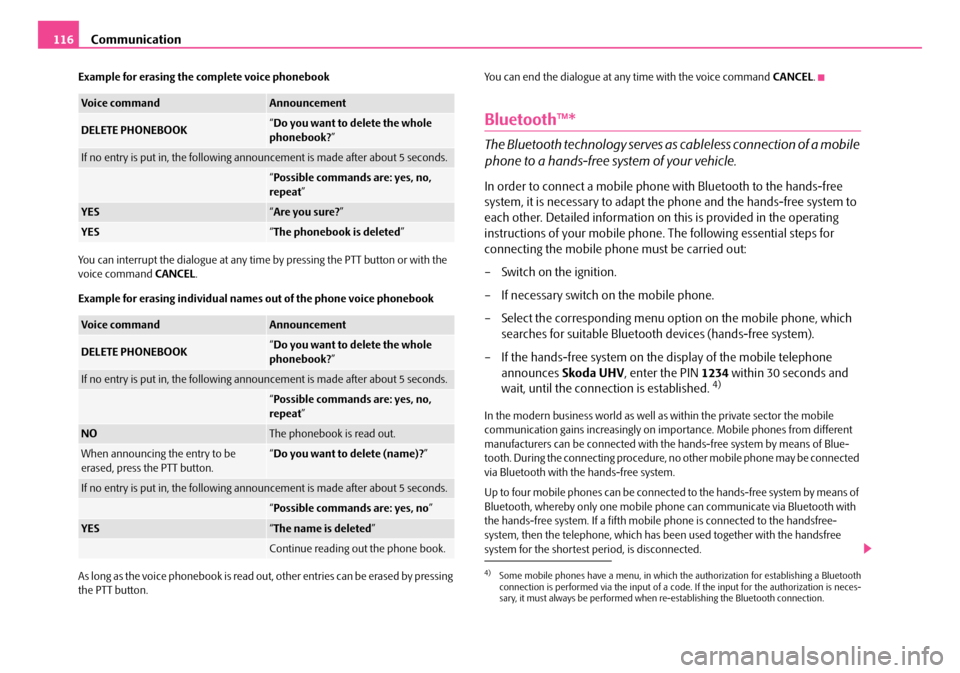
Communication116
Example for erasing the complete voice phonebook
You can interrupt the dialogue at any time by pressing the PTT button or with the voice command CANCEL.
Example for erasing individual names out of the phone voice phonebook
As long as the voice phonebook is read out, other entries can be erased by pressing the PTT button.
You can end the dialogue at any time with the voice command CANCEL.
Bluetooth™*
The Bluetooth technology serves as cableless connection of a mobile
phone to a hands-free system of your vehicle.
In order to connect a mobile phone with Bluetooth to the hands-free
system, it is necessary to adapt the phone and the hands-free system to
each other. Detailed information on this is provided in the operating
instructions of your mobile phone. The following essential steps for
connecting the mobile phone must be carried out:
– Switch on the ignition.
– If necessary switch on the mobile phone.
– Select the corresponding menu option on the mobile phone, which
searches for suitable Bluetooth devices (hands-free system).
– If the hands-free system on the display of the mobile telephone
announces Skoda UHV, enter the PIN 1234 within 30 seconds and
wait, until the connection is established. 4)
In the modern business world as well as within the private sector the mobile communication gains increasingly on importance. Mobile phones from different manufacturers can be connected with the hands-free system by means of Blue-tooth. During the connecting procedure, no other mobile phone may be connected via Bluetooth with the hands-free system.
Up to four mobile phones can be connected to the hands-free system by means of Bluetooth, whereby only one mobile phone can communicate via Bluetooth with the hands-free system. If a fifth mobile phone is connected to the handsfree-system, then the telephone, which has been used together with the handsfree system for the shortest period, is disconnected.
Voice commandAnnouncement
DELETE PHONEBOOK“Do you want to delete the whole phonebook?”
If no entry is put in, the following announcement is made after about 5 seconds.
“Possible commands are: yes, no, repeat”
YES“Are you sure?”
YES“The phonebook is deleted”
Voice commandAnnouncement
DELETE PHONEBOOK“Do you want to delete the whole phonebook?”
If no entry is put in, the following announcement is made after about 5 seconds.
“Possible commands are: yes, no, repeat”
NOThe phonebook is read out.
When announcing the entry to be erased, press the PTT button.“Do you want to delete (name)?”
If no entry is put in, the following announcement is made after about 5 seconds.
“Possible commands are: yes, no”
YES“The name is deleted”
Continue reading out the phone book.
4)Some mobile phones have a menu, in which the authorization for establishing a Bluetoothconnection is performed via the input of a code. If the input for the authorization is neces-sary, it must always be performed when re-establishing the Bluetooth connection.
NKO A05F 20.book Page 116 Wednesday, April 2, 2008 1:02 PM
Page 118 of 252

Communication117
Using the systemSafetyDriving TipsGeneral MaintenanceBreakdown assistanceTechnical Data
Establishing the Bluetooth connection
After switching on the ignition, the Bluetooth connection is automatically estab-lished for the already adapted mobile phone 4). You can hear an increasing tone sequence from the loudspeakers of the vehicle.
Disconnecting the Bluetooth connection
After withdrawing the ignition key, the Bluetooth connection is disonnected. You can hear an increasing tone sequence from the loudspeakers of the vehicle.
WARNING
•Pay attention primarily to the traffic situation! As the driver you are fully responsible for road safety. Use the telephone system only to such an extent, so that you are in full control of your vehicle at any time - risk of accident!
•In the event of air transport, the Bluetooth function of the handsfree-system must be switched off by a specialist garage.
Caution
Taking the mobile phone out of the adapter during the call can lead to interruption of the connection. When taking out the mobile phone, the connection to the factory-fitted antenna is interrupted, this reduces the quality of the transmitting and receiving signal. This might result additionally in harmful radiation from the mobile phone in the interior of the vehicle and the charging of the telephone battery is interrupted.
Note
•Not valid for all mobile phones which enable a communication via Bluetooth.
•Please operate your mobile phone exclusively with a suitable adapter, in order to keep a low radiation in the vehicle.
•Inserting the mobile phone into the adapter ensures an optimal sending and receiving power and offers at the same time the advantage of the battery charging.
•If you insert the mobile telephone into the adapter, the connection is estab-lished via the interface in the adapter set and the Bluetooth connection is discon-
nected. You can hear an increasing tone sequence from the loudspeakers of the vehicle.
•Note that the range of the Bluetooth connection to the handsfree-system is limited to the vehicle interior. The range is dependent on local factors, e.g. obstacles between the devices and interferences with other devices. If your mobile phone is e.g. in a jacket pocket, this can lead to difficulties when establishing the Bluetooth connection with the handsfree-system or the data transfer.
•If you have set the Portuguese language in the information display, it is used automatically for the mobile phone operation, as this is the language, which was entered during coding of the handsfree-system.
•On certain mobile phones with operating system, it is necessary to install on the mobile phone an application of the mobile phone manufacturer, which enables the take-over of the phone phonebook via Bluetooth.
Mobile phones and two-way radio systems
We recommend that you have the installation of a mobile phone and two-way radio system in a vehicle carried out by a Škoda Service Partner.
Škoda Auto a.s. permits the operation of mobile phones and two-way radio systems with a professionally installed external aerial and a maximum transmission power of up to 10 watts.
Our Škoda Service Partners are also happy to inform you about the possibilities available for installing and operating mobile telephones and radio transmitters which have an output greater than 10 watts. The Škoda Service Partners can provide you with details about the technical possibilities for retrofitting of mobile tele-phones and radio transmitters.
Operation of mobile phones or two-way radio systems may interfere with func-tioning of the electronic systems of your vehicle. The reasons for this may be:
•no external aerial,
•external aerial incorrectly installed,
•transmission power greater than 10 watts.
NKO A05F 20.book Page 117 Wednesday, April 2, 2008 1:02 PM
Page 119 of 252
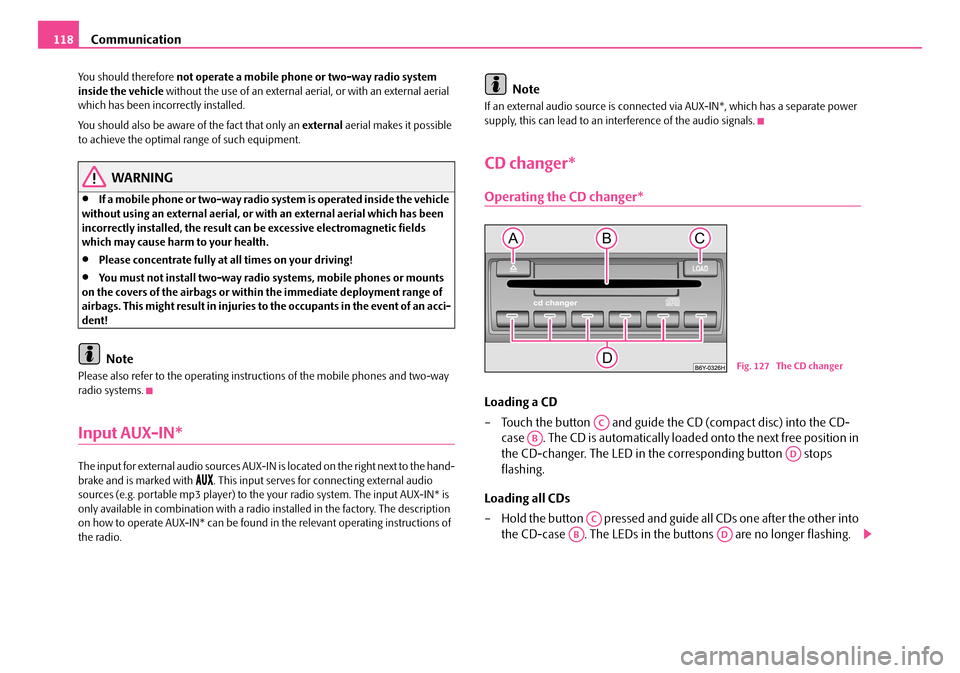
Communication118
You should therefore not operate a mobile phone or two-way radio system inside the vehicle without the use of an external aerial, or with an external aerial which has been incorrectly installed.
You should also be aware of the fact that only an external aerial makes it possible to achieve the optimal range of such equipment.
WARNING
•If a mobile phone or two-way radio system is operated inside the vehicle without using an external aerial, or with an external aerial which has been incorrectly installed, the result can be excessive electromagnetic fields which may cause harm to your health.
•Please concentrate fully at all times on your driving!
•You must not install two-way radio systems, mobile phones or mounts on the covers of the airbags or within the immediate deployment range of airbags. This might result in injuries to the occupants in the event of an acci-dent!
Note
Please also refer to the operating instructions of the mobile phones and two-way radio systems.
Input AUX-IN*
The input for external audio sources AUX-IN is located on the right next to the hand-brake and is marked with . This input serves for connecting external audio sources (e.g. portable mp3 player) to the your radio system. The input AUX-IN* is only available in combination with a radio installed in the factory. The description on how to operate AUX-IN* can be found in the relevant operating instructions of the radio.
Note
If an external audio source is connected via AUX-IN*, which has a separate power supply, this can lead to an interference of the audio signals.
CD changer*
Operating the CD changer*
Loading a CD
– Touch the button and guide the CD (compact disc) into the CD-
case . The CD is automatically loaded onto the next free position in
the CD-changer. The LED in the corresponding button stops
flashing.
Loading all CDs
– Hold the button pressed and guide all CDs one after the other into
the CD-case . The LEDs in the buttons are no longer flashing.
Fig. 127 The CD changer
AC
AB
AD
AC
ABAD
NKO A05F 20.book Page 118 Wednesday, April 2, 2008 1:02 PM
Page 120 of 252
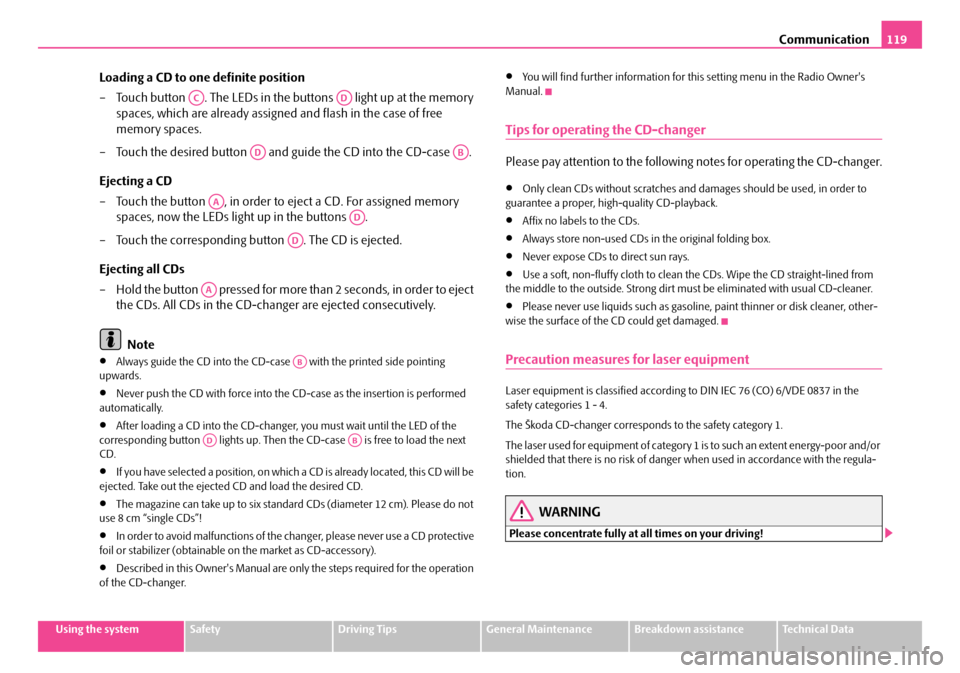
Communication119
Using the systemSafetyDriving TipsGeneral MaintenanceBreakdown assistanceTechnical Data
Loading a CD to one definite position
– Touch button . The LEDs in the buttons light up at the memory
spaces, which are already assigned and flash in the case of free
memory spaces.
– Touch the desired button and guide the CD into the CD-case .
Ejecting a CD
– Touch the button , in order to eject a CD. For assigned memory
spaces, now the LEDs light up in the buttons .
– Touch the corresponding button . The CD is ejected.
Ejecting all CDs
– Hold the button pressed for more than 2 seconds, in order to eject
the CDs. All CDs in the CD-changer are ejected consecutively.
Note
•Always guide the CD into the CD-case with the printed side pointing upwards.
•Never push the CD with force into the CD-case as the insertion is performed automatically.
•After loading a CD into the CD-changer, you must wait until the LED of the corresponding button lights up. Then the CD-case is free to load the next CD.
•If you have selected a position, on which a CD is already located, this CD will be ejected. Take out the ejected CD and load the desired CD.
•The magazine can take up to six standard CDs (diameter 12 cm). Please do not use 8 cm “single CDs”!
•In order to avoid malfunctions of the changer, please never use a CD protective foil or stabilizer (obtainable on the market as CD-accessory).
•Described in this Owner's Manual are only the steps required for the operation of the CD-changer.
•You will find further information for this setting menu in the Radio Owner's Manual.
Tips for operating the CD-changer
Please pay attention to the following notes for operating the CD-changer.
•Only clean CDs without scratches and damages should be used, in order to guarantee a proper, high-quality CD-playback.
•Affix no labels to the CDs.
•Always store non-used CDs in the original folding box.
•Never expose CDs to direct sun rays.
•Use a soft, non-fluffy cloth to clean the CDs. Wipe the CD straight-lined from the middle to the outside. Strong dirt must be eliminated with usual CD-cleaner.
•Please never use liquids such as gasoline, paint thinner or disk cleaner, other-wise the surface of the CD could get damaged.
Precaution measures for laser equipment
Laser equipment is classified according to DIN IEC 76 (CO) 6/VDE 0837 in the safety categories 1 - 4.
The Škoda CD-changer corresponds to the safety category 1.
The laser used for equipment of category 1 is to such an extent energy-poor and/or shielded that there is no risk of danger when used in accordance with the regula-tion.
WARNING
Please concentrate fully at all times on your driving!
ACAD
ADAB
AA
AD
AD
AA
AB
ADAB
NKO A05F 20.book Page 119 Wednesday, April 2, 2008 1:02 PM
Page 123 of 252
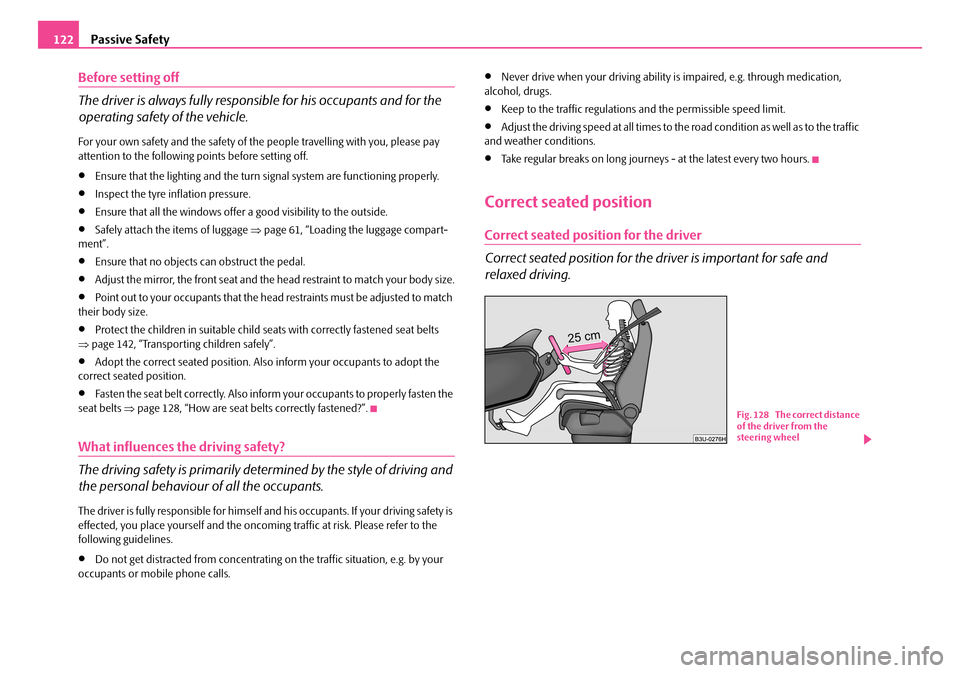
Passive Safety122
Before setting off
The driver is always fully responsible for his occupants and for the
operating safety of the vehicle.
For your own safety and the safety of the people travelling with you, please pay attention to the following points before setting off.
•Ensure that the lighting and the turn signal system are functioning properly.
•Inspect the tyre inflation pressure.
•Ensure that all the windows offer a good visibility to the outside.
•Safely attach the items of luggage ⇒page 61, “Loading the luggage compart-ment”.
•Ensure that no objects can obstruct the pedal.
•Adjust the mirror, the front seat and the head restraint to match your body size.
•Point out to your occupants that the head restraints must be adjusted to match their body size.
•Protect the children in suitable child seats with correctly fastened seat belts ⇒page 142, “Transporting children safely”.
•Adopt the correct seated position. Also inform your occupants to adopt the correct seated position.
•Fasten the seat belt correctly. Also inform your occupants to properly fasten the seat belts ⇒page 128, “How are seat belts correctly fastened?”.
What influences the driving safety?
The driving safety is primarily determined by the style of driving and
the personal behaviour of all the occupants.
The driver is fully responsible for himself and his occupants. If your driving safety is effected, you place yourself and the oncoming traffic at risk. Please refer to the following guidelines.
•Do not get distracted from concentrating on the traffic situation, e.g. by your occupants or mobile phone calls.
•Never drive when your driving ability is impaired, e.g. through medication, alcohol, drugs.
•Keep to the traffic regulations and the permissible speed limit.
•Adjust the driving speed at all times to the road condition as well as to the traffic and weather conditions.
•Take regular breaks on long journeys - at the latest every two hours.
Correct seated position
Correct seated position for the driver
Correct seated position for the driver is important for safe and
relaxed driving.
Fig. 128 The correct distance of the driver from the steering wheel
NKO A05F 20.book Page 122 Wednesday, April 2, 2008 1:02 PM
Page 125 of 252
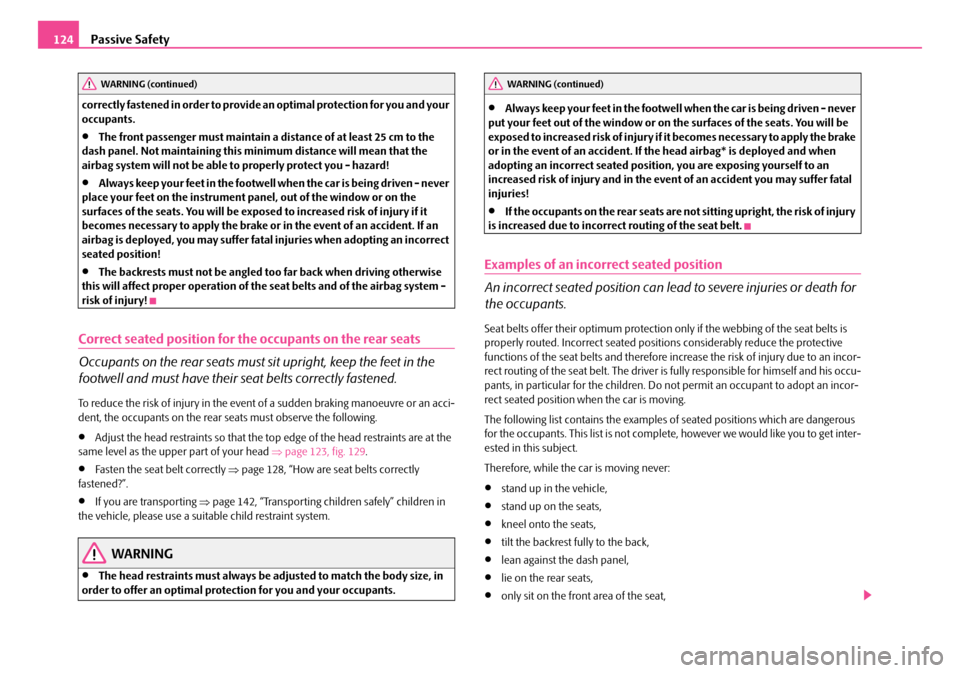
Passive Safety124
correctly fastened in order to provide an optimal protection for you and your occupants.
•The front passenger must maintain a distance of at least 25 cm to the dash panel. Not maintaining this minimum distance will mean that the airbag system will not be able to properly protect you - hazard!
•Always keep your feet in the footwell when the car is being driven - never place your feet on the instrument panel, out of the window or on the surfaces of the seats. You will be exposed to increased risk of injury if it becomes necessary to apply the brake or in the event of an accident. If an airbag is deployed, you may suffer fatal injuries when adopting an incorrect seated position!
•The backrests must not be angled too far back when driving otherwise this will affect proper operation of the seat belts and of the airbag system - risk of injury!
Correct seated position for the occupants on the rear seats
Occupants on the rear seats must sit upright, keep the feet in the
footwell and must have their seat belts correctly fastened.
To reduce the risk of injury in the event of a sudden braking manoeuvre or an acci-dent, the occupants on the rear seats must observe the following.
•Adjust the head restraints so that the top edge of the head restraints are at the same level as the upper part of your head ⇒page 123, fig. 129.
•Fasten the seat belt correctly ⇒page 128, “How are seat belts correctly fastened?”.
•If you are transporting ⇒page 142, “Transporting children safely” children in the vehicle, please use a suitable child restraint system.
WARNING
•The head restraints must always be adjusted to match the body size, in order to offer an optimal protection for you and your occupants.
•Always keep your feet in the footwell when the car is being driven - never put your feet out of the window or on the surfaces of the seats. You will be exposed to increased risk of injury if it becomes necessary to apply the brake or in the event of an accident. If the head airbag* is deployed and when adopting an incorrect seated position, you are exposing yourself to an increased risk of injury and in the event of an accident you may suffer fatal injuries!
•If the occupants on the rear seats are not sitting upright, the risk of injury is increased due to incorrect routing of the seat belt.
Examples of an incorrect seated position
An incorrect seated position can lead to severe injuries or death for
the occupants.
Seat belts offer their optimum protection only if the webbing of the seat belts is properly routed. Incorrect seated positions considerably reduce the protective functions of the seat belts and therefore increase the risk of injury due to an incor-rect routing of the seat belt. The driver is fully responsible for himself and his occu-pants, in particular for the children. Do not permit an occupant to adopt an incor-rect seated position when the car is moving.
The following list contains the examples of seated positions which are dangerous for the occupants. This list is not complete, however we would like you to get inter-ested in this subject.
Therefore, while the car is moving never:
•stand up in the vehicle,
•stand up on the seats,
•kneel onto the seats,
•tilt the backrest fully to the back,
•lean against the dash panel,
•lie on the rear seats,
•only sit on the front area of the seat,
WARNING (continued)WARNING (continued)
NKO A05F 20.book Page 124 Wednesday, April 2, 2008 1:02 PM
Page 132 of 252
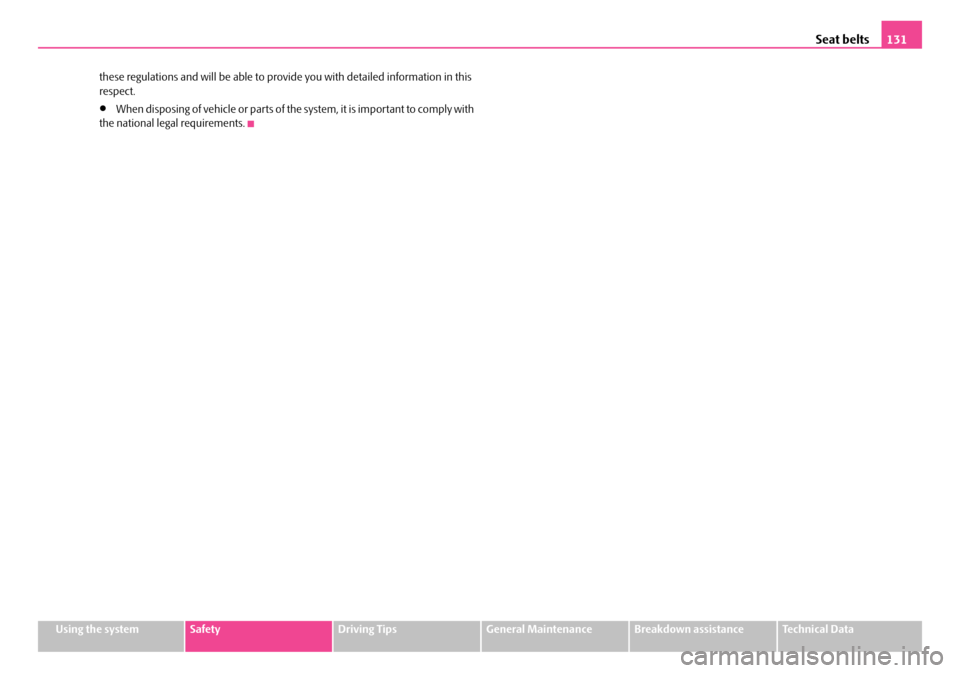
Seat belts131
Using the systemSafetyDriving TipsGeneral MaintenanceBreakdown assistanceTechnical Data
these regulations and will be able to provide you with detailed information in this respect.
•When disposing of vehicle or parts of the system, it is important to comply with the national legal requirements.
NKO A05F 20.book Page 131 Wednesday, April 2, 2008 1:02 PM